
archaeological site of Troy, Turkey
The archaeological site of Troy is located in western Turkey near the convergence of the Aegean Sea and the Dardanelles (ancient Hellespont), the strait that connects the Aegean to the Bosphorus and the Black Sea, a strategic location valuable to whomever controls it.
Excavations have revealed 9 main layers of settlement going back 5 thousand years. The Troy immortalized by Homer in the Iliad, which tells the story of the final months of a 10 year siege of Troy by a coalition of Greek states, has been placed in layer VIIa, dated to around 1250 BCE. Scholars generally agree that the Iliad is a fictionalized, mythologized account of an actual conflict, but that the war was most likely over control of the Hellespont and trade access to the Black Sea, rather than the abduction of Helen, the queen of Sparta, as Homer tells it.
Factual or not, the Iliad is full of very human characters and dramatic force that are embedded in the foundation of Western culture and still compelling 3000 years later. Troy is one of the most visited archaeological sites in the world, not because of a 3000 year old dispute over territory, but because of the mythical proportions of the characters and events placed there by Homer.
So, that’s what we’re looking at in this post and the previous post, the story of Troy, the people (both mortal and immortal) and relationships that continue to give it life even now, when it physically bears little resemblance to its actual or imaginary self.
When we left off in the last post, the assembled Greek warriors had just set sail for Troy, having purchased good winds with the life of Agamemnon’s daughter Iphigenia. They’re headed to get Helen, wife of Menelaus, king of Sparta, back from Paris, prince of Troy, who took her.
Paris was exceptionally good-looking but not particularly courageous. What made him think he could get away with stealing the wife of a king? Aphrodite, goddess of love, that’s what, or who. I don’t mean in a metaphorical “love will find a way” sense but in a literal sense, at least as literal as it gets in the realm of myth and legend. Here’s the story: Eris, the goddess of discord, was bitter because she was not invited to the wedding party of the hero Peleus and the sea-nymph Thetis. Eris was a troublemaker by nature. She took her revenge by tossing a golden apple into the party inscribed with the words “for the fairest.” The apple was instantly claimed by three goddesses – Hera, Athena and Aphrodite, all very beautiful and vain. None was willing to defer to another, so they took the case to Zeus. Zeus was far too smart to get involved, especially considering one of the goddesses was his wife Hera, so he appointed the unsuspecting mortal Paris as judge. The three goddesses appeared before Paris in a field, where he was tending sheep, and lobbied hard for his vote. Hera promised to make him the king of Europe and Asia. Athena offered to make him a great warrior. Aphrodite vowed to give him the love of the world’s most beautiful woman, Helen of Sparta. You know how that contest ended. Aphrodite was declared the fairest and the fate of Troy was sealed then and there. Not only was Paris about to bring the enmity of Greece down on his city, but the wrath of two goddesses as well. Troy was doomed. But it wouldn’t be a quick and merciful end.
The siege of Troy lasted 10 years. Paris fought for his city but his brother Hector was by far the nobler warrior and man. Considering all the trouble Paris had caused, you can’t blame Hector for being hard on him, which he was, in a brotherly way. Mostly, Hector was busy trying to save the city and his family. Most of Troy called for the return of Helen to Menalaus. Unfortunately, the big softy King Priam supported his son’s desire to keep Helen and treated her as a daughter.
Meanwhile, in the Greek camp Agamemnon and the great warrior Achilles squabbled over Briseis, the queen of a Trojan ally captured in battle, and endanged their cause in the process. Briseis belonged to Achilles and Agamemnon took her, so Achilles refused to fight. He was the Greek’s best warrior and in his absence they lost a lot of ground. After his friend Patroclus was killed by Hector, Achilles returned to the battlefield in a fit of grief, mowing down Trojan soldiers until the river ran red with blood. Eventually he met Hector and killed him.

Greek vase painting of the battle of Hector and Achilles
That’s pretty much the end of the Iliad but from other sources we learn about the wooden horse and the sack of Troy. Odysseus, the wily King of Ithaca, devised the plan to hide their best fighters inside a giant wooden horse, leave it at the gates of Troy and sail away. The Trojans fell for this and brought the horse inside. After dark, the hidden Greeks came out of the horse and opened the gates to the entire Greek army, which hadn’t sailed away very far. That was the end of Troy.

replica of the wooden horse, Troy, Turkey

Greek vase painting of the sack of Troy
Paris and Hector had been killed on the battle field, along with many other Trojans and allies of Troy, and most of those who survived the siege died in the sack of the city, including King Priam. Agamemnon survived the war and returned to Mycenae only to be killed by his wife Clytemnestra, who hated him for sacrificing their daughter Iphigenia. More about that in my previous post. (That family’s tragedy goes on and on.) Menelaus and Helen returned to Sparta.

ruins at Troy, Turkey

ruins at Troy, Turkey

ruins at Troy, Turkey
To visit Troy, spend the night in Canakkale, about a 30 minute drive away. Many people find the site disappointing. It does take some imagination, and a good guide, to connect with the history of the place but I wouldn’t miss it, especially if you’re a nerd for the Classics.
Click to see tours that include Troy on our web site.






















